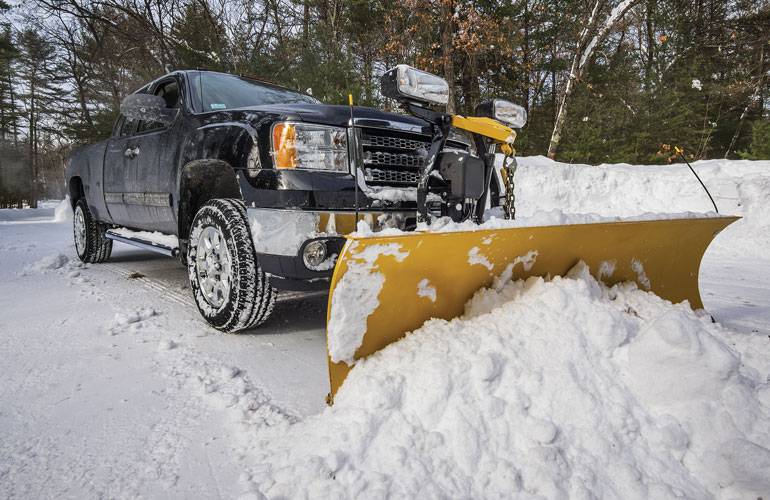Article By ANNE COSGROVE, (Photo: Adobe Stock Christian Delbert)
Virtually every industry has been changed by the pandemic. From minor inconveniences due to a change in protocol to major disruptions in livelihoods, the COVID-19 pandemic has changed industries and businesses of all shapes and sizes. All this against a backdrop of shifting economic, social, and environmental conditions. Business owners are working to adapt to the impacts this evolving landscape presents, and those running snow and ice management service companies are part of this tide.
Demand for services, increased concern for people’s safety, and environmental and other regulations are part of what’s feeding growth in the snow and ice management industry. So, while a demand for these services is no doubt welcomed by stakeholders, there are changes that bring both opportunities and challenges. We’ll look at a few here.
Labor Shortage
Finding and retaining good employees is always a challenge for business owners and managers. This has become a more significant challenge, given the impacts of the pandemic. A shortage of applicants has many snow and ice operators struggling to find employees for this winter season. And, the industry is not alone.
Neal Glatt, managing partner of GrowTheBench.com, providing education to the snow management industry through the Snowfighters Institute, keeps a close eye on the labor statistics across the nation. When we spoke in September, Glatt pointed out the shortage is not altogether new: “Since 2010, the labor market has been tight. Currently, the unemployment rate is 5.1%. That is eight million people out of work, with 11 million jobs available. There’s not enough people to fill the jobs; one reason is Baby Boomers aging out of the workforce.”
So with pandemic pressure adding to a more than decade-long trend, snow and ice business owners and other operators may be trying to hire without significant success. An increase in work is a positive, but some are finding they cannot meet the demand due worker shortage.
“Workforce availability is a leading constraint,” observes Phill Sexton, founder and CEO of WIT Advisers, a firm serving the landscape and winter management industry for a diversity of stakeholders. “The majority of contractors, municipalities, and in-house operations we work with are needing to fill at least 20% of their positions,” he continues. “A few are even looking to hire 50% or more of the people they need to complete the work they have on the books currently.”
Technology & Equipment
Continued improvement and adoption of technology across the snow and ice industry is helping contractors and other operators to achieve higher efficiencies in carrying out jobs. Snow/ice equipment, communication tools, software, and more feature advancements each year that offer faster, more accurate, and even, safer, ways to do the work. Of course, this requires investment and training. Still, when you find a technology tool that helps fill a need, it’s can be well worth that investment.
“At Snowfighters Institute events, we hear, ‘I can’t find enough people [to hire],’” says Glatt. “Some are raising prices, some are stopping their sales season early, and others are investing in technology.”
Mobile technology, software, GPS for trucks/equipment, and automated equipment are areas where contractors are adopting new ways of performing work and servicing their customers.
Glatt highlights several ways technology is in use, “There are apps for crews in the field to communicate. They can submit photos and information about their work. On the business side, there’s automated billing and invoicing. And technology is being used for equipment maintenance and supply level tracking.”
Environment & Regulations
Sexton’s WIT Advisers advises and onboards organizations that want to transition snow and ice services to an environmentally-friendly (sustainable) model. The firm works with both contractors and clients (e.g., property owners, municipalities) to implement its Sustainable Winter Management (SWiM®) guidelines.
He says, “Our clients in this sector are primarily property owners/managers who are desiring or requiring their service providers (contractors) to follow SWiM guidelines or environmental agencies, NGOs, and water quality initiatives who are in need of significantly reducing road salt chloride loading in a particular watershed or region.”
Technology plays a role here, and Sexton explains, “Measuring being the first of the SWiM guidelines requires measuring material outputs, particularly road salt, and requires monitoring and measuring levels of service (LOS). Continuous improvement and optimization are enabled through the use of new segmented plow and brine technologies that enable contractors, municipalities, and in-house grounds operations to increase levels of service and further decrease road salt outputs. Even ‘robots’ are starting to play a role in how the work is produced.”
Glatt is also seeing the increase in environmental concerns at Snowfighters Institute, noting the rise in use of liquid deicers. They are seeing, “contractors using liquid either directly or treating rock salt with liquid deicer, which puts less chlorides into the environment.”
As the social, technology, and environmental aspects overlap to impact the snow and ice industry, political moves are a significant force also. Sexton offers his insight: “Legislation activity, particularly related to road salt application usage and liability reform preventing property owners from transferring their liability to contractors are the top political issues state legislative bodies are focusing on in a variety of states. In New York, the state passed its first version of road salt usage and is forming a road salt reduction task force. New Hampshire has a model legislation that is being proposed in several other state houses throughout the northeast and mid-west including Maine, Vermont, Massachusetts, and Minnesota. Several other states have adopted legislation that prevents property owners/managers from transferring their liability to contractors they hire, including Colorado, New Jersey, and Connecticut.”
Moving Forward
So, with the snow and ice season straight ahead, consider the changes and how these have been affecting your 2021-22 season. And, consider the insights here as you plan for next year.
Says Sexton, “The snow and ice industry continues to evolve. And growth requires the industry to focus on how to sustain itself through constant change.”
Glatt points to education as a tool for contractors to move forward in the industry. “This could be in the form of online or in-person events, reading publications like Turf, or investing in themselves and their employees,” he says. “Over the past 10 years, there has been a lot of change in the economy, and this is going to continue.”
Find out more about Snowfighters Institute: www.SnowfightersInstitute.com. Find out more about WIT Advisers: www.WITAdvisers.com.
Cosgrove is Editor-in-Chief of Turf.


Recent Comments